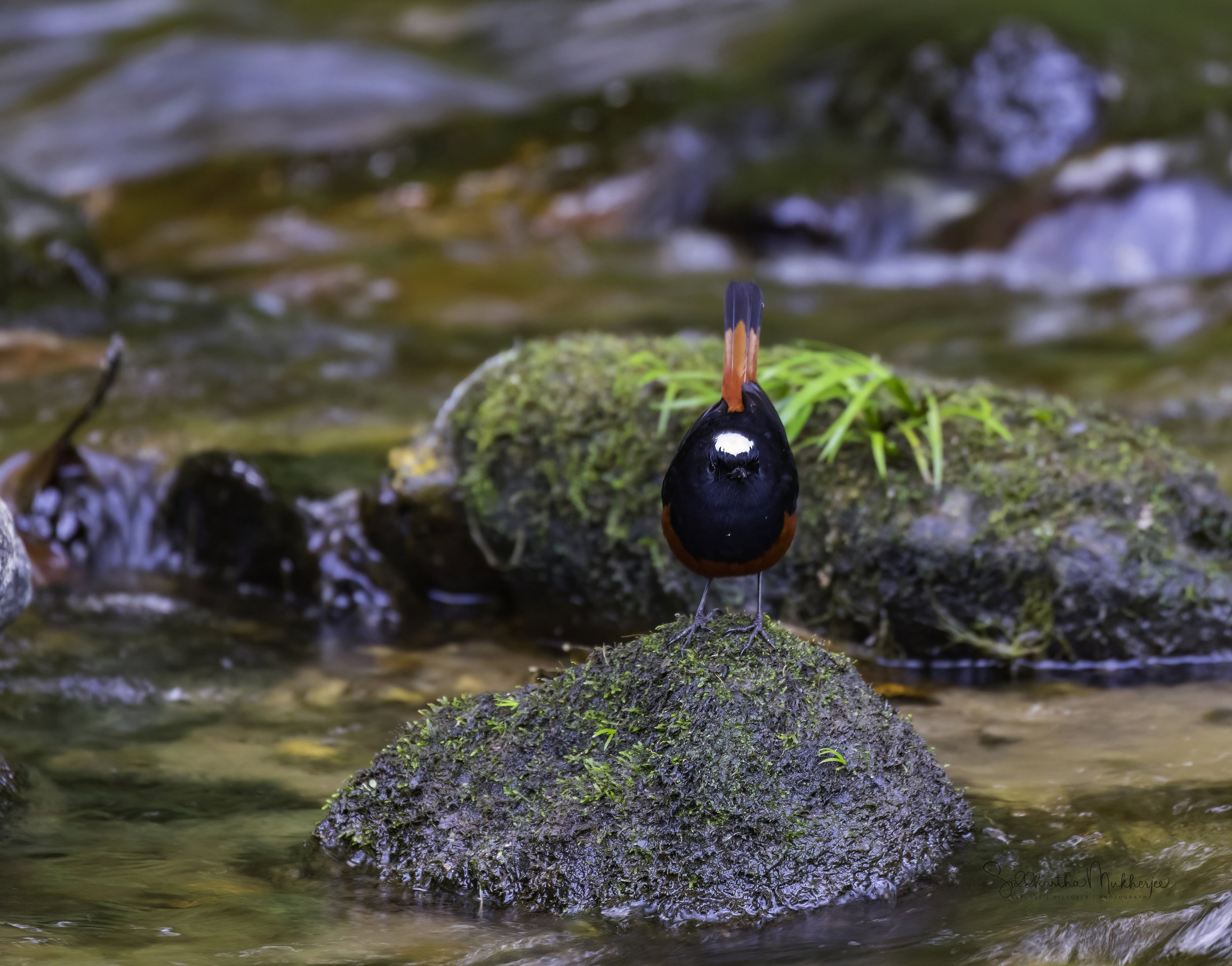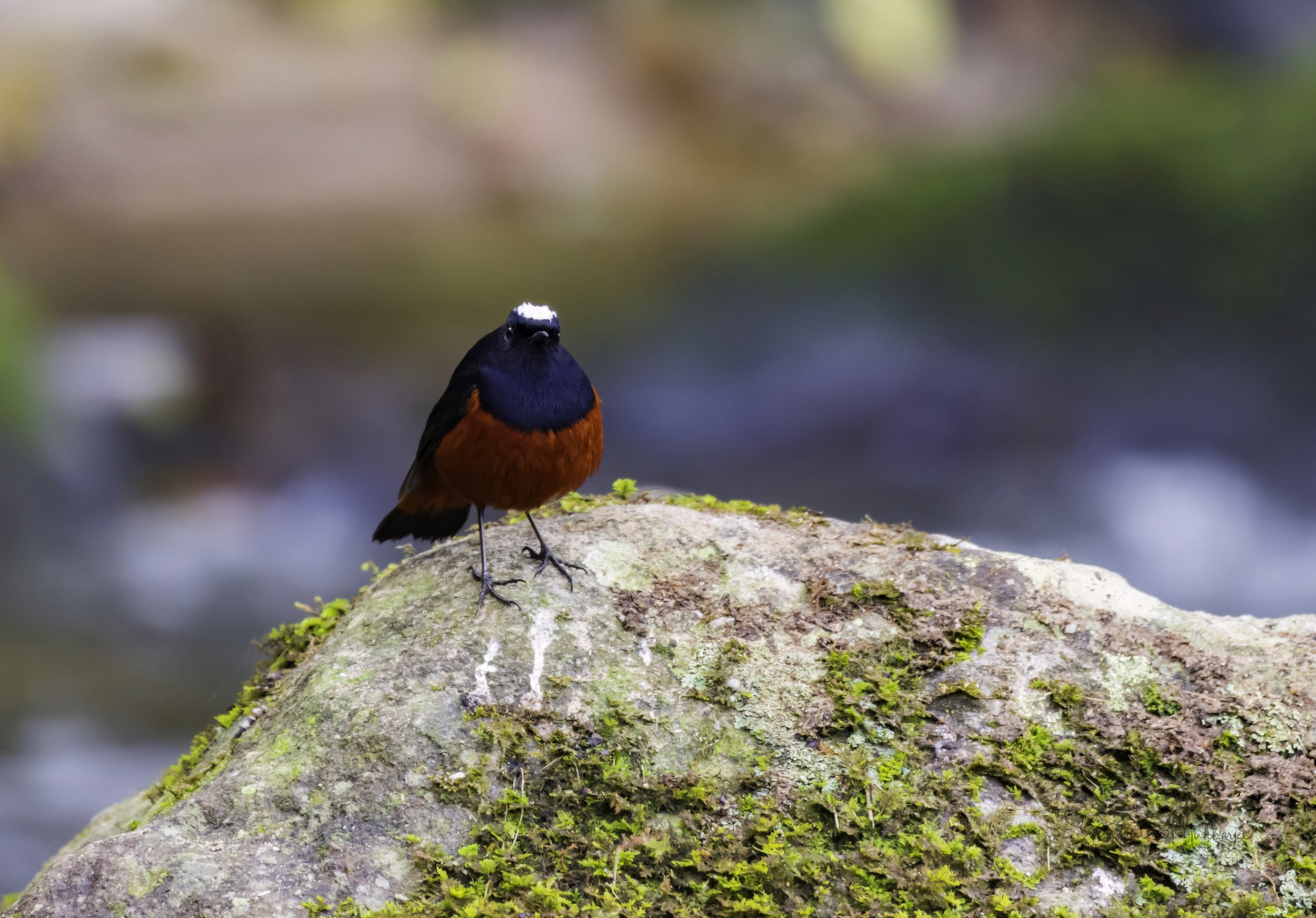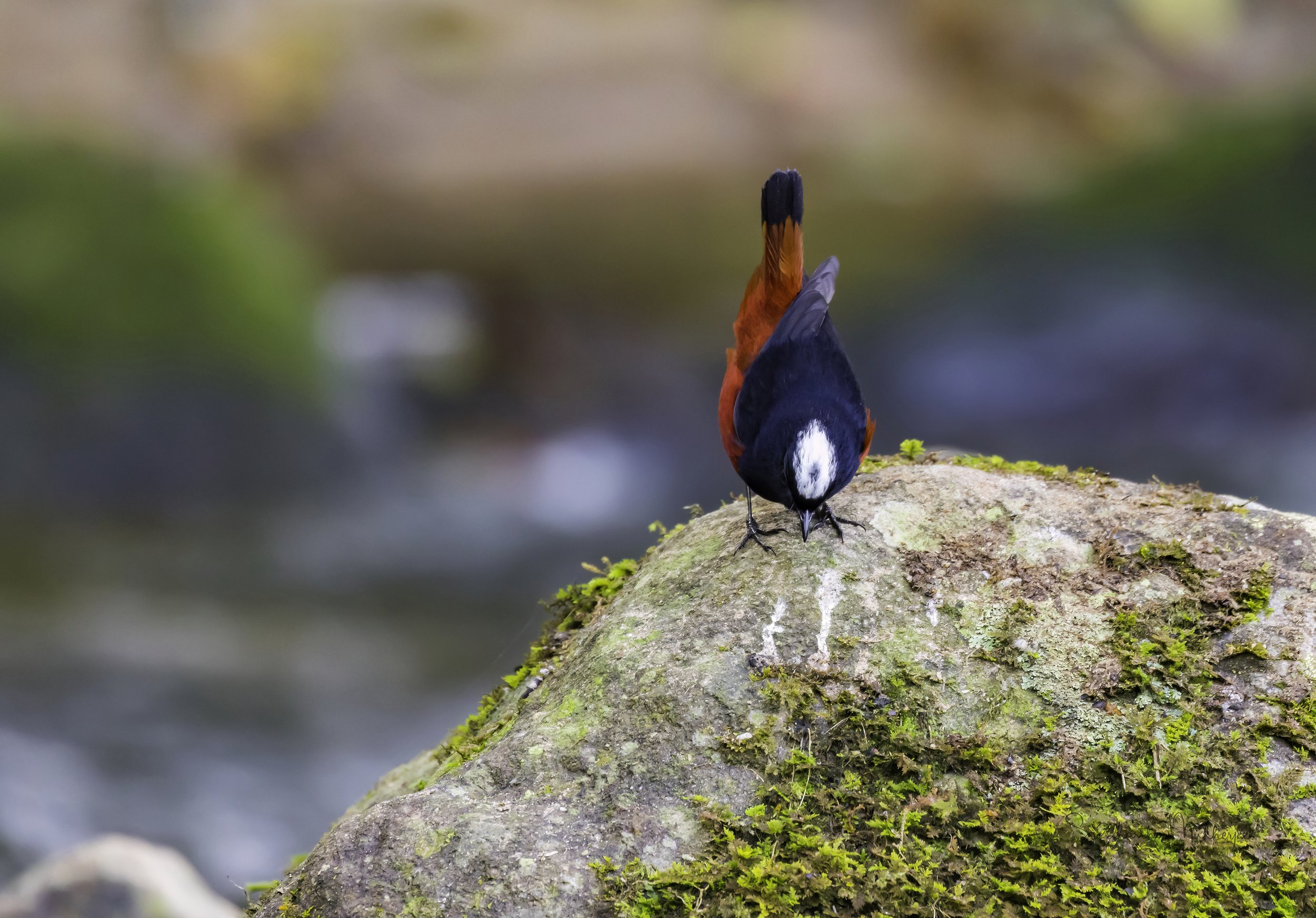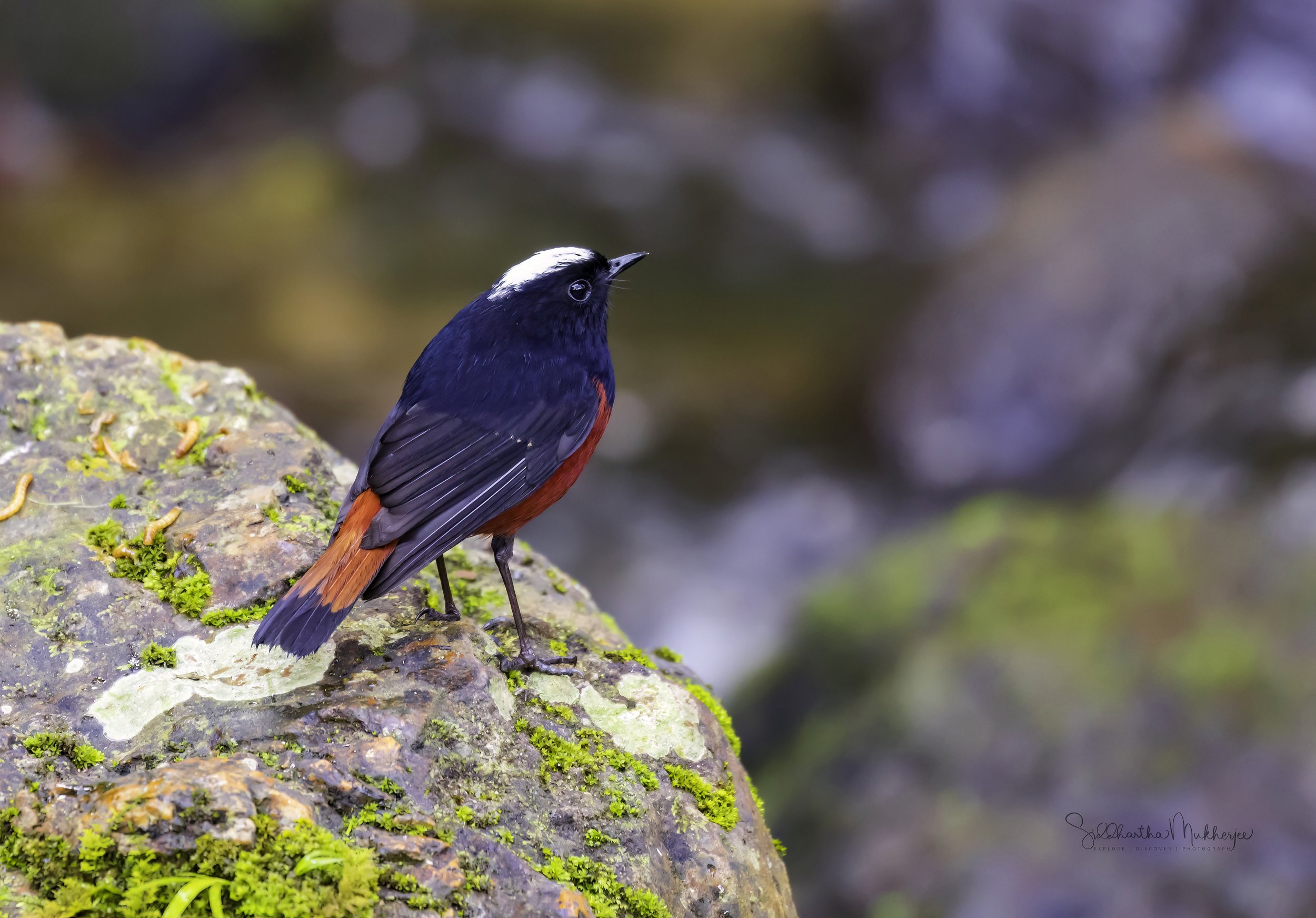White-capped Redstart/ White-capped Water Redstart
Phoenicurus leucocephalus
Doi Inthanon National Park, Thailand
Thailand is home to one of the oldest and richest ecosystems in the world - its rainforests. These rainforests date back more than 140 million years and is home to many species endemic to Thailand, many of which are endangered. While trekking through the rainforest, one is surrounded by an array of sounds, smells and sights some of which I have tried to capture. I have been able to spend a considerable amount of time in some of these rainforests experiencing the diverse wild and birdlife that thrive here. What you see here are glimpses of Doi Pha Hom Pok, Kaeng Krachan & Doi Inthanon National Parks. Doi Inthanon National Park, also known as "The Roof of Thailand", is famous for its waterfalls, few trails, remote villages, sunrises & sunsets, birdwatching and the all year round cold weather at higher elevations. And on one of the gurgling streams down the mountain I came across this White-capped Redstart.
Doi Inthanon National Park, Thailand
Doi Inthanon is Thailand’s highest mountain and a site of unique biological interest supporting a fascinating variety of vegetation and a higher bird species total than any other protected area. Of the total of 382 species of birds so far known from Doi Inthanon, at least 266 species are residents or were formerly residents on the mountain. Doi Inthanon is of particular conservation importance for those species which inhabit the moist hill evergreen forests of the upper slopes. Some, such as the Chestnut-tailed Minla and White-browed Shortwing, which are around the summit, occur in Thailand only on those few higher mountain summits which have considerable areas of hill evergreen forest above 1800 m. Doi Inthanon contains the only significant protected populations of such species in Thailand. The Ashy-throated Leaf-Warbler is found nowhere else in Thailand while an endemic race of the Green-tailed Sunbird (Aethopyga nipalensis angkanensis), is also completely confined to the summit. The Wachirathan Waterfall is one of the best sites for observing birds of fast-flowing streams. The Plumbeous Redstart and the River Chat often perch on boulders in mid-stream. The Slaty-backed Forktail can sometimes be seen. Among the many scarce arboreal birds to look out for are the Long-tailed Broadbill, Brown-throated Treecreeper, Green Cochoa and Purple Cochoa and Black – tailed Crake.
Read about some of the beautiful and fascinating birds I have seen on these slopes:
Kaeng Krachan National Park is located in Phetchaburi and Prachuap Khiri Khan Provinces, about 60 km from Phetchaburi and 75 km from Hua Hin. It is bounded by the Tanintharyi Nature Reserve along Myanmar's border to the west and part of the Western Forest Complex that covers 18,730 km² across 19 protected sites between Myanmar and Thailand. There are two main rivers in the park; Phetchaburi and Pran Buri Rivers. Both rivers originate from the Tanaosri Mountain Range. In the north, Phetchaburi River flows into Kaeng Krachan Dam and flows further east all the way out to the Gulf of Thailand. Pran Buri River flows south to Prachuap Khiri Khan Province, into Pran Buri Reservoir and out to the Gulf of Thailand.
The highest elevation in the park is a peak along the Burmese border at around 1,500 meters. The park is popular for wildlife which doesn’t necessarily mean it is easy. The possibilities depend on the seasons and seasonal conditions for various types of animals. Mammals like leopards, clouded leopards, bears, stump-tailed macaques, sambhar, barking deer, elephants, dholes, golden jackal, gaur, serows, crab-eating mongoose and tapirs can be spotted in the park. There also used to be a significant tiger population in the park up until a decade ago, but only a few are left now.
Langurs, stump-tailed macaques, white-handed gibbons, sambhar, mouse deer, porcupines, monitor lizards, civets and black giant squirrel are frequently seen. White-handed gibbons can be seen or heard nearly every day, often seen at the edge of the campsites.
Read about the tigers I have spent time with.
‡‡‡‡‡
‡‡‡‡‡
White-capped Redstart
The White-capped redstart or White-capped water redstart (Phoenicurus leucocephalus) is a passerine bird of the Old World flycatcher family Muscicapidae native to the Indian Subcontinent, Southeast Asia, much of China, and to certain regions of Central Asia.
The White-capped is a chunky, brightly-colored redstart found along rushing boulder-strewn mountain streams. It is black with a wine-red belly and tail and a blazing white cap. In poor lighting, it appears all dark save for the cap. It frequently flicks its tail up and down and flares it open while perched on a streamside rock or stump. And its call is a long, sharp whistle with an abrupt ending, with a far-carrying, ventriloquial quality - as can be heard in the background of my video.
The white-capped redstart is about 18–19 cm long and weighs about 24–42 grams. It bobs its body after landing, and wags a partly-fanned tail while drooping its wings. It has a blazing white cap with a black head going down its back and wings. and down to the breast; otherwise it is orange-chestnut with black terminal tail bar, black bill and legs. The sexes are similar but the juvenile is like the adult with a scaled black white cap, more grey-black above and extending below to the lower belly, with paler buff-grey tips on lower breast to mid-belly and an orange-grey vent.
The white-capped breeds along larger rapid mountain streams as can be heard in the video, frequenting boulders amidst the rushing water but visiting wet mossy cliffs and steep marshy hillsides. It is usually seen between 1800–5100 m, mainly 2400–4200 m, in the Himalayas. In the winters it frequents clear shingly rivers and canals from the lowlands to the foothills. In higher elevations it may nest in rocky alpine meadows several kilometers from running water.
It is distributed from East Uzbekistan, South West Kyrgyzstan, Tajikistan and North Afghanistan East through the Himalayas to Central & North East China (N to N Qinghai and Hebei, E to Anhui), North Myanmar and North Vietnam. The non-breeding range is at lower levels South to Central Myanmar, North Thailand, North & Central Laos and South East China (including Hainan). It is an Altitudinal and short-distance migrant. In China it is reported to move south in the winters. In Afghanistan and NW Himalayas the white-capped redstart makes elevational movements, but these less pronounced in area East from Kashmir with the species being present throughout year in some areas. In India it descends to lower levels and this has been noted throughout October, with ascents beginning in spring around the end of March and beginning of April. It moves up to breeding areas in Nepal during April, some continuing to do so in May and Jun, following the melting of the snows.
The White-capped feeds on Insects, including ephemeropterans, dipteran flies, notably craneflies, beetles and ants, also spiders and molluscs; occasionally berries (including aroid berries and Berberis), grass seeds. It takes food from the surface of water or in erratic flycatching sallies, also dashing in and out among rocks, and by wading in shallow water. It occasionally forages for short periods away from water on rock-strewn ground and cliffs. In a study in Nepal, 60% of observations of foraging position involved marginal rocks, 22% mid-river rocks, 15% riparian ground and 3% shoals or marginal ground; prey-picking techniques 40% from riparian ground or vegetation, 39% from rocks, 19% in aerial sally and 2% from shoals or mud. Most of the photos I was able to take were when it took breaks on these rocks between sallies.
The song of the White-capped Redstart is a protracted melodious, undulating, but rather weak and melancholy whistling, with an almost ventriloquial quality, “tieu-yieu-yieu-yieu”, lasting less than 1 second, repeated every 5–6 seconds. Also, the song by the male during courtship with the female is variable and highly complicated, heard only at close range. The call itself is a sharp shrill long-drawn upslurred “tseee” or “tseeit” or “shviiit!” in alarm, apparently also serving territorial purpose, and changing in quality with elevation, from 3900 m upwards in Nepal having a clinking timbre (and reported in N Thailand as a sharp “ping”); also a much-repeated “tik” and wheezy ascending “wheet”. Some of the can be heard in the video in the background.
The breeding season is May–Jul/Aug and commonly double-brooded. The territory can be small in optimal habitat with pairs every 100–200 m of river. The nest itself is a bulky, deepish cup of grass, moss and rootlets, strengthened with mud, lined thickly with rootlets, ferns and/or animal hair, placed deep in rock cleft or hole in tree or under overhanging bank, often in half-hollow end of broken trunk or log in riverbed, sometimes under stone or tree roots. 3-5 eggs are laid which are a greenish or bluish-green with reddish-brown spotting and purplish-grey blotches. There is no information on incubation and fledging periods but the young are fed for 5–6 days after fledging.
The White-capped Redstart is listed on the IUCN Red List as Least Concern or not globally threatened. They are uncommon in mountains of Central Asia but locally common in Pakistan; in Kagan Valley one bird is seen every 300 m over 96 km, with an estimated 300 pairs on this stretch of river. They are also common in India, common to very common in China, uncommon to fairly common in N Myanmar and N Indochina, also a common winter visitor to Myanmar foothills, but uncommon in North Thailand, where they may be only a non-breeding visitor but this is where I have seen them almost every time I have been here.
‡‡‡‡‡
Related Posts





























